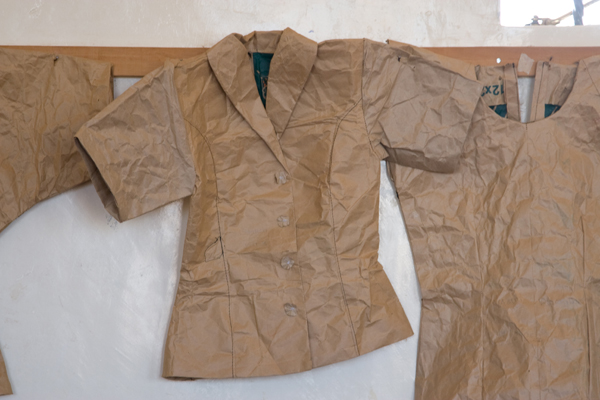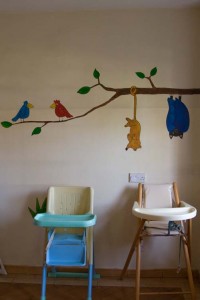Our last day prior to the safari featured two quick stops: The BCC campus and the New Life Babies Home. I have written quite a bit about the BCC, so I'll keep it short.
The BCC (Baptist Children's Center) is a Buckner-managed facility. Here is a blurb from the Buckner website:
Buckner began operations in Kenya in 2002 with the assumption of the Baptist Children’s Center (BCC) located in the Njiru location of Embakasi Division, Maili Saba Village. In 2001, Arms of Jesus requested Buckner assume responsibility for operations of BCC. Actual ownership of the campus remained with the Baptist Association of Kenya as it does to this day. The Manager’s house and cafeteria buildings were added in the same year. They were followed by the girls’ and boys’ dormitories in the following year and in 2004 the first two education buildings were added with one for the preschool and kindergarten while the other for the technical training program. In 2006, construction was initiated for expansion of the BCC school with the goal of expanding through the 8th grade. Completion of the 1st through 4th grade building was finished in 2007.
The campus now has 3 school buildings in addition to the Technology Center. As I've previously written, this is a huge advantage for many of the children as they no longer have to walk long distances to school. In addition, BCC/Buckner have more control over the quality of education to which the children are exposed. Since the children have so few options upon leaving the BCC, education is paramount in providing avenues for employment. Here is a photo showing some of the school buildings:

---------------------------------------------------------------
The Technology Center is used, currently, to teach sewing to young ladies. The goal of this program is, of course, to provide a marketable skill so they are able to find employment. As Tony Wenani (BCC Manager) explained to us, the girls are taught and tested up to a certain proficiency level, and then leave to find an internship or further instruction. Once this process is finished, the girls are (typically) able to find work. The photo below shows the sewing tables (with the machines removed and locked away).

Because fabric is expensive, and thus rare, the girls learn and practice using brown paper. Only after they have perfected their technique using paper are they allowed to progress to using actual fabric. I found the paper dresses to be fascinating:

It was a quick tour of the BCC, but as always I was very impressed with the facility, the program, the commitment of the staff...everything. It was good to see Tony and his family, and I also got to see one of my all-time favorite kids, Charles (Charles and I have a close bond).
---------------------------------------------------------------
After the BCC, we traveled to a babies home in Nairobi, the "New Hope Babies Home." This amazing facility serves to provide a home for abandoned babies, most of whom have HIV. As you might imagine, a baby, particularly an HIV-positive baby, born to a poor family, would be considered great burden. As such, many such babies are abandoned.
You can read about the New Life Babies Home here. Once we arrived, those who had been to the facility before were able to immediately jump in and play with the babies. For those of us making our first visit, we enjoyed a tour of the facility first. Some thoughts:
- The buildings and facilities were very, very clean and well organized. There was a critical care room, complete with incubator. There were several different "units" for different age babies. There was a room for potty-training. There were play rooms, feeding rooms, sick rooms...this place had almost everything you would need to raise 50+ babies.
- According to our guide, almost all of the staff were volunteers. People from around the globe (it seemed) would show up at the home to spend time with the babies. Administration and management staff was paid, I assume, but there were many volunteers there.
- According to our guide, many of the HIV-positive babies had reverted to HIV-negative after receiving care and treatment. I had never heard of this even being possible, but our guide insisted this was case. Amazing!
Below are some photos from the Babies Home:






All in all, this day taught me (or, reminded me) amazing things are going on in Kenya. God is using all sorts of people to accomplish all sorts of things. He is providing teachers and buildings and sewing machines and paper so young ladies can have a chance to earn a living. He is providing people like Tony Wenani to manage the BCC in such a way that both the orphans who live there and the surrounding community benefit. He is providing volunteers and funding and facilities and medical assistance and generous, open hearts so that abandoned babies can live. And He is, in some mysterious way, allowing these babies born with HIV to escape from the clutches of this dread disease.
Yes, God is doing these things. But I am reminded time and time again that his instruments are people, and this, I suppose, is the greatest lesson I've learned. I'm a "people," you're a "people,"...we're all "people." And as such, we can, and should, all be instruments for God to use is some fashion. What a challenge, what a calling.
Next up: the Safari (Lions and Hippos and Secretary Birds, oh my!)
 Wednesday, February 18, 2009 at 12:53AM
Wednesday, February 18, 2009 at 12:53AM 






















